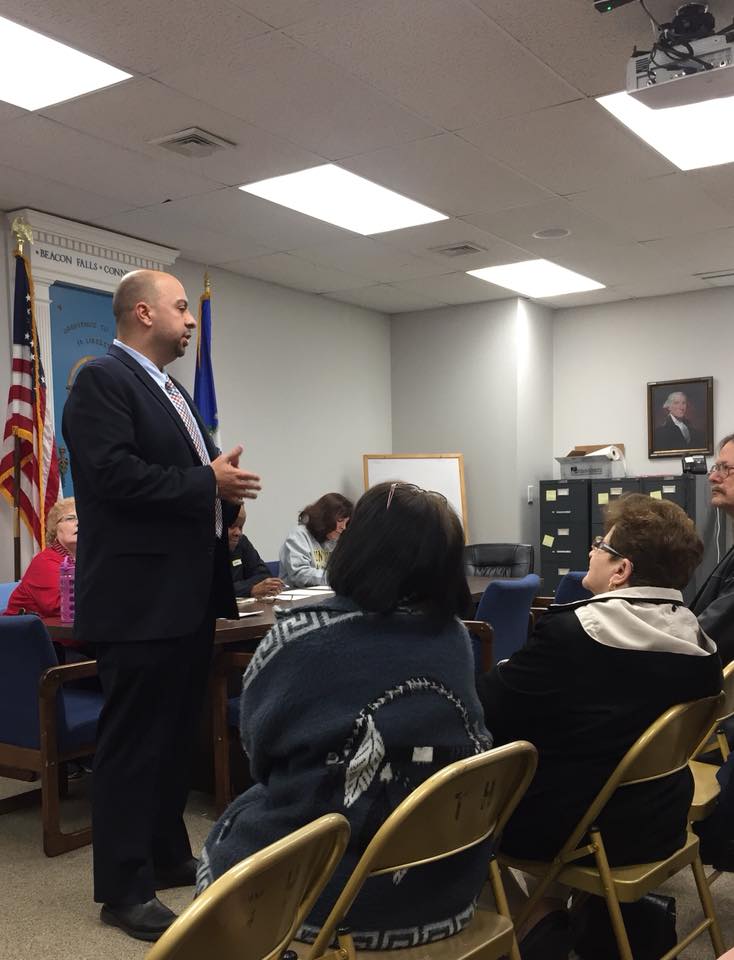
By Sal Siciliano
Jorge Cabrera has lived in Connecticut his entire life. During his childhood, his father worked long hours in a factory and often took on a second job to support his family.
Cabrera and his wife Rebecca graduated from Quinnipiac University in 1998 when the tuition was just $27 thousand a year. It has more than doubled since then.
Now as a father of two, Cabrera is running for State Senate in the 17th District as a Democrat. He hopes to win the seat over Republican George Logan to update the struggling Connecticut economy.
Scott McLean, Quinnipiac political science chairperson and associate political science professor, remembers Cabrera as a “politically aware and socially engaged student.”
As a student, McLean said that Cabrera, who was elected as the SGA president his junior year, helped to improve the political science program as a whole and understood the importance of political involvement in his peers.
McLean also remembers Cabrera working to help the non-academic working staff on campus.

Cabrera with wife Rebecca and their twin boys Gabe and Jorgie.
“He was always advocating on behalf of the staff on campus,” McLean said. “And he did have an impact on students who picked up on that advocacy after he graduated.”
Cabrera’s mission is to bring more opportunities to hardworking people across Connecticut.
“In Connecticut there was a time, when my parents were raising me, where it was assumed that the harder you work the luckier you get,” Cabrera said. “It seems like that story is less common now.”
With a degree in political science and hands-on experience in student government, Cabrera went to work as a legislative aid for the first female Speaker of the House after graduation in 1998.
After starting a family, Cabrera and his wife experienced similar challenges to what he had seen his parents face.
“We struggled to make ends meet too. I had to get a second job,” Cabrera said. “My wife is a school teacher, she had to put in extra hours working summer school to make extra money for us.”
Cabrera is motivated by his life experiences to secure a Senate seat for the 17th district, made up of the town of Hamden (where he has lived for 13 years), Woodbridge, Ansonia, Derby, Beacon Falls, Bethany and Naugatuck.
“We need to invest more in Connecticut,” said Cabrera. He feels that the only way to give back to the state’s working class is by jumpstarting the quality of the state’s institutions.
His plan for improvement begins with Connecticut’s children, specifically the state’s public schools.
“We need to fully fund our public schools. We haven’t been doing that,” said Cabrera. “The quality of your public schools can attract businesses and also is a big reason why people make a decision to move somewhere.”
Next up for Cabrera is infrastructure.
“Our bridges, our roads, our rails, they have been neglected for a long time,” Cabrera said. “Connecting all of our communities is vital for attracting businesses who want to come here.”
Improving these facets of the state, Cabrera believes, will stimulate Connecticut’s economy and offer more jobs for people joining the workforce, which he feels has been becoming increasingly more limited.
“I am constantly meeting people on the campaign trail who have college degrees and are still living at home with their parents because they can’t find a good paying job with their degree,” Cabrera said. “That narrative wasn’t as common when I was growing up and even when I got out of school. If you got a degree somewhere you were pretty much assured a job somewhere.”
College is the third pillar of Cabrera’s plan. He wants to make it more affordable and eliminate student debt. For those that are not interested in college, Cabrera feels that the state’s trade school needs improvement as well.
“Many people I run across want to be a plumber, or a pipe fitter, or a carpenter, or a steel worker. Jobs that are good paying middle-class jobs with the right training programs,” Cabrera said. “We need to do more to invest in those programs and apprenticeship programs, because those (are) sorely needed.”
Cabrera’s mission is shared by many young politicians in Connecticut, that hope to see changes in the state with their involvement. The last election for the Hamden Democratic Committee alone brought 26 new members.
“The energy that young people bring, and the passion, is vital.A lot of the issues we have to solve directly impact college students and younger people,” Cabrera said. “We need to make sure that young people have a voice at the table.”
But young people can only have that voice if they get involved, said Cabrera.
“When you graduate, be aware of what’s going on and speak up. In our country that’s always the way it’s been. When young people get involved things change,” said Cabrera. “College grads and young people are more powerful than they realize, and their voices are powerful too.”
The election for state senate will take place on Nov. 6.

